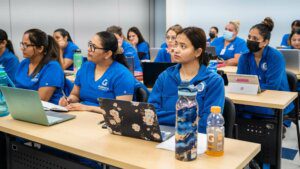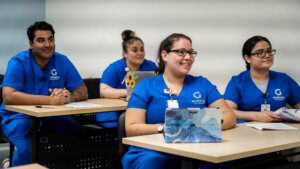3 Reasons to Shift From a CNA to an MA
Date: November 16, 2022
Monday Morning
- Another day! Race to put on the scrubs—regret that the dark green scrubs are still in the wash.
- Place coffee on the dashboard. Drive.
- Enter work. (Take coffee with you.) Clock in.
- Race toward the Resident’s Lobby. Make a mental note to turn the TV volume down. (Who keeps cranking it up so loud?)
- Pass the Activities Room. Make another mental note to add to the previous mental note to circle back and check the glue and construction paper got put away properly. (What part of “please put away your materials” does the new Activities Director miss?)
- Jet past Mrs. Jones’ room. (Dear, sweet, sweet Mrs. Jones! Cross your fingers her children visited her this weekend like they said they would.) Pray they did.
- Grab the stethoscope and clipboard. Smile. Sip coffee.
- “Marathon-through” morning wake-ups, recording vitals, and dressing patients.
- Chart. Drink more coffee.
- Push wheelchairs to the kitchen and back. Rinse and Repeat.
A Day in the Life of a CNA
Route memory, feeding, bathing—sometimes even a tear when a patient passes on… The rewards of being a Certified Nursing Assistant (CNA) come in ample waves. Yet, even while loving caregiving, maybe something’s missing. Perhaps you envisioned “living the dream” translated to a bit more flexibility? Other times, you surprised yourself that charting relaxed you and you wouldn’t mind adding clerical tasks to your day. Occasionally, you’re even remiss if you didn’t study a geriatric specialty—after all, these patients are fascinating.
Shifting to MA Interests
If you nodded “yes” to any of the above, you might not just be having another routine work day. Instead, you may be shifting your interests toward medical assisting (MA). To an outsider, CNA and MA roles might seem very similar. Both interact with Sweet Mrs. Jones, right? Both help patients. While the answers to these are both “yes” and “yes,” there are some significant advantages to becoming an MA.
CNA and MA roles generally have the following job descriptions.
CNA Tasks |
MA Tasks |
|
|
Turn or reposition bedridden patients.1 |
Interview patients to obtain medical information and take vital signs.2 |
|
|
Answer call signals to determine patients’ needs.1 |
Clean and sterilize instruments and dispose of contaminated supplies.2 |
|
|
Feed or assist patients in eating or drinking.1 |
Record patients’ medical histories and other information.2 |
|
|
Measure and record food and liquid intake or urinary and fecal output, reporting changes to medical staff.1 |
Explain treatment procedures, medications, diets, or physicians’ instructions to patients.2 Delegated electrocardiography, finger sticks, and CLIA-waived tests…venepuncture.8 |
|
|
Provide physical support to assist patients in performing daily activities. These may include getting out of bed, bathing, dressing, using the toilet, standing, walking, or exercising.1 |
Help physicians and teams with patient examinations. However, MAs may also schedule and confirm patient appointments and perform data entry tasks.3 |
|
|
Typically work in patients’ rooms.3 |
Typically work in reception areas.3 |
|
|
Often assist with primary patient care and everyday tasks.3 |
Prepare treatment rooms for patient examinations, keeping rooms/clean.2 |
Advantages of Becoming an MA
Primarily, becoming an MA provides some significant advantages. These include
a) More Professional Options,
b) Greater Flexibility or Variance in Tasks,
c) Routes for Healthcare Specialty Advancement.
These benefits are unpacked below:
1. More Personal Options
MAs may work in various settings.4 While some arrive at traditional brick-and-mortar physicians’ offices, others quite literally “phone it in.” Modern MA venues include telephonic, remote, and virtual work-from-home options.
So while some MAs provide medical advice needing only a good wifi connection and an open chat box, others work from their suitcases. Because their work is crucial and wellness environments depend on them. Recent healthcare shortages have created per diem travel contracts for adventurous MAs.4
However, MA options aren’t just in the work environment but also in scheduling. MAs might hold 3 AM shifts at local hospitals or maintain “banker’s hours” with holiday times off at boutique clinics. They may work full-time or part-time.4 MA work isn’t seasonal, and every state4 depends on them. Because of this, relocation usually isn’t a big concern.
Moreover, work options are as diversified as the MAs that fill them.
2. Flexibility/Variance in Tasks
Whether front- or back-office: administrative or clinical, an MA’s day has no lack of variety.4 Their day can range from classic office functions such as answering the phone. Or it may be clinical, such as weighing a patient. Moreover, the MA vocation may be strictly operational such as completing electronic medical charts. But, an MA role can be AND + OR. Consequently, while some MAs singularly work in one area, others form a hybrid–performing duties dually.
For this reason, MAs are sometimes called the most versatile allied health professionals. A day’s work might mean processing medical billing or negotiate with insurance companies. Or it could mean acting as a part medical liaison, facilitating communications between a doctor and patient.
3. Routes For Specialties and Advancement
Provided you have the right qualifications and an eagerness to learn, MA opportunities abound. Front-office MAs commonly have options to advance to office managers. While back-office MAs might use their education as bridges to nursing degrees or specialties.5 Still, MAs with real-life experience and further credentialing seek options as teachers within higher education.4
Because an MA education forms a solid base, some MAs use that footing as a bridge for going into other healthcare vocations.4 Or they might use MA training transactionally to work, return to school, and specialize in their interests. Some MAs seek arrangements with employers for tuition reimbursements.
“One of the many wonders of this career is that MAs can work with doctors in every medical field. So, whether one’s interested in obstetrics or podiatry, there’s more often than not an MA position in that particular field of practice.”8
In Summary
For the reasons above, MAs work in some highly specialized areas. These include optometrists’ offices, assisting with minor eye surgeries at ophthalmology clinics, or doing light work alongside chiropractors. Others help gynecologists/obstetricians or specialize as cardiology technicians.†9
Do you think an MA shift is in your future? You might owe it to yourself to check into the profession. We’d love to help you make the switch. To get additional information, click here.
P.S. Don’t forget to check on Sweet Mrs. Jones’ weekend. ~
Citations:
1^a, b, c, d, e “31-1131.00–Nursing Assistants.” O*NET OnLine, National Center for O*NET Development. (Accessed Oct. 27, 2022.)
2^a, b, c, d, e “31-9092.00–Medical Assistants.” O*NET OnLine, National Center for O*NET Development. (Accessed Oct. 27, 2022.)
3^a, b, c, d Editorial Staff. “Medical Assistant vs. Nursing Assistant: What’s the Difference?” Indeed Career Guide, Indeed. Oct. 13, 2022. (Accessed Oct. 27, 2022.)
4 Schlette, MSN, RN, Jennifer. “25 Reasons Why Medical Assistant Is a Good Career Choice.” Nursing Process.Org, 2022. (Accessed Nov. 8, 2022.)
5 “10 Reasons to Choose a Medical Assisting Career.” Indeed. Indeed Career Guide, Mar. 2020. (Accessed Nov. 8, 2022.)
6 “Top Reasons to Pursue Medical Assistant Job Today.” ResuMeds. Dec. 16, 2019. (Accessed Nov. 8, 2022.)
7 Jackson, Chris. “20 Awesome Places Where Medical Assistants Can Work.” Medical Assistant Guide, CMA/RMA Guide for Medical Assistants.™ Jan. 15, 2018. (Accessed Nov. 3, 2022.)
8 Balasa, Donald “Medical Assistants’ Competence in Performing Diagnostic Tests. CMA Today. (Accessed Nov. 14, 2022)






